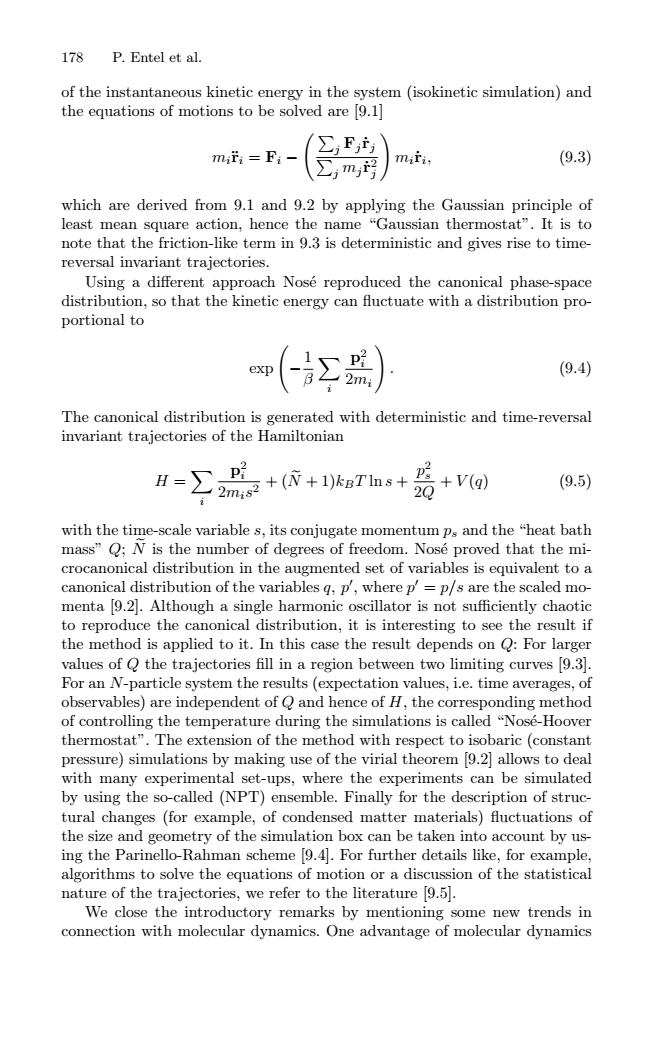正在加载图片...

178 P.Entel et al. of the instantaneous kinetic energy in the system (isokinetic simulation)and the equations of motions to be solved are 9.1 mifi=F miti, (9.3) which are derived from 9.1 and 9.2 by applying the Gaussian principle of least mean square action,hence the name "Gaussian thermostat".It is to note that the friction-like term in 9.3 is deterministic and gives rise to time- reversal invariant trajectories. Using a different approach Nose reproduced the canonical phase-space distribution,so that the kinetic energy can fluctuate with a distribution pro- portional to (9.4) 2m The canonical distribution is generated with deterministic and time-reversal invariant trajectories of the Hamiltonian W-∑器+i+1e7ns+ +Vq (9.5) 20 with the time-scale variable s,its conjugate momentum ps and the"heat bath mass"Q;N is the number of degrees of freedom.Nose proved that the mi- crocanonical distribution in the augmented set of variables is equivalent to a canonical distribution of the variables q,p,where p=p/s are the scaled mo- menta 9.2].Although a single harmonic oscillator is not sufficiently chaotic to reproduce the canonical distribution,it is interesting to see the result if the method is applied to it.In this case the result depends on Q:For larger values of Q the trajectories fill in a region between two limiting curves [9.3. For an N-particle system the results (expectation values,i.e.time averages,of observables)are independent of Q and hence of H,the corresponding method of controlling the temperature during the simulations is called "Nose-Hoover thermostat".The extension of the method with respect to isobaric(constant pressure)simulations by making use of the virial theorem [9.2]allows to deal with many experimental set-ups,where the experiments can be simulated by using the so-called (NPT)ensemble.Finally for the description of struc- tural changes (for example,of condensed matter materials)fluctuations of the size and geometry of the simulation box can be taken into account by us- ing the Parinello-Rahman scheme [9.4.For further details like,for example, algorithms to solve the equations of motion or a discussion of the statistical nature of the trajectories,we refer to the literature [9.5]. We close the introductory remarks by mentioning some new trends in connection with molecular dynamics.One advantage of molecular dynamics178 P. Entel et al. of the instantaneous kinetic energy in the system (isokinetic simulation) and the equations of motions to be solved are [9.1] mi¨ri = Fi −
j Fjr˙j j mjr˙2 j
mir˙ i, (9.3) which are derived from 9.1 and 9.2 by applying the Gaussian principle of least mean square action, hence the name “Gaussian thermostat”. It is to note that the friction-like term in 9.3 is deterministic and gives rise to timereversal invariant trajectories. Using a different approach Nos´e reproduced the canonical phase-space distribution, so that the kinetic energy can fluctuate with a distribution proportional to exp
− 1 β i p2 i 2mi
. (9.4) The canonical distribution is generated with deterministic and time-reversal invariant trajectories of the Hamiltonian H = i p2 i 2mis2 + (N4 + 1)kBT ln s + p2 s 2Q + V (q) (9.5) with the time-scale variable s, its conjugate momentum ps and the “heat bath mass” Q; N4 is the number of degrees of freedom. Nos´e proved that the microcanonical distribution in the augmented set of variables is equivalent to a canonical distribution of the variables q, p , where p = p/s are the scaled momenta [9.2]. Although a single harmonic oscillator is not sufficiently chaotic to reproduce the canonical distribution, it is interesting to see the result if the method is applied to it. In this case the result depends on Q: For larger values of Q the trajectories fill in a region between two limiting curves [9.3]. For an N-particle system the results (expectation values, i.e. time averages, of observables) are independent of Q and hence of H, the corresponding method of controlling the temperature during the simulations is called “Nos´e-Hoover thermostat”. The extension of the method with respect to isobaric (constant pressure) simulations by making use of the virial theorem [9.2] allows to deal with many experimental set-ups, where the experiments can be simulated by using the so-called (NPT) ensemble. Finally for the description of structural changes (for example, of condensed matter materials) fluctuations of the size and geometry of the simulation box can be taken into account by using the Parinello-Rahman scheme [9.4]. For further details like, for example, algorithms to solve the equations of motion or a discussion of the statistical nature of the trajectories, we refer to the literature [9.5]. We close the introductory remarks by mentioning some new trends in connection with molecular dynamics. One advantage of molecular dynamics����